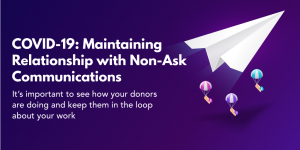You don’t need us to tell you it’s a good idea to A/B test your nonprofit’s communications.
But when you’re hitting your fundraising goals, and things are good, it can become a little too tempting to maintain the status quo. But you should always be looking for ways to help your nonprofit grow.
“If it isn’t broken, don’t fix it” doesn’t apply to nonprofits!
As fundraisers, it’s critical for us to be proactive rather than reactive. We owe it to the causes we serve and our donors who want to make a difference. We should always look for ways to raise more and make a bigger impact.
Don’t forget, an A/B test is one of the best ways to better understand your donors’ preferences. It will help you learn what adjustments can improve your results and advance your mission.
So, has it been a while since you ran an A/B test? Here are a few things to keep in mind before your next one.

What are you trying to answer?
First things first. Make sure you have an end goal in mind before you make any major changes to your outreach materials.
You wouldn’t decide what route was best for your road trip without knowing your destination. And you need to understand what you’re trying to achieve before moving forward with your A/B testing.
Having a clear goal, like improving your click rate or increasing your average gift size, will help you determine what direction to take and get started. If you’re trying to increase giving, you know that you need to test different ask strings, for example.
You might use different examples of impact in your call-to-action to see if you can inspire donors to increase their support. Or even see if there are different ways of telling the same story in your appeal.
It’s all about finding out what resonates best with your audience!
Let’s start with your emails.
Think about the first two things you see in every email.
Obviously, the subject and sender are a great place to start A/B testing your emails!
Are donors more likely to engage with your email if it comes from your development director or a board member? Will thanking a donor for their past support in the subject line generate more clicks?
But you also need to consider how a donor’s experience once they open your email will influence their engagement.
And don’t forget to think strategically about your design! You can test two different layouts against each other and see which donors like best. Or you can test a highly stylized email against one that looks like it was typed moments before it was sent.
Every organization’s donors are different and have different preferences. So, we don’t know what will have the biggest impact on your audience. But an A/B test can give you the answer!
READ MORE: 4 ways nonprofits use data to optimize email outreach.

What about direct mail?
A/B testing your emails makes adjusting and learning as you go easy. And it’s a familiar way to get back in the swing of it! But it’s important to experiment with your direct mail communications too.
You won’t have the luxury of advanced analytics about each touch from a mass email platform like Campaign Monitor or MailChimp. But you can still learn a lot about your donor’s preferences from your direct mail response rate.
And you can use a slightly different link and/or QR code on each version of your mailer. This gives you an easy way to see how many donors visited your website after receiving your direct mail piece’s A or B version.
But you can also experiment with things like the envelope on your appeal letter. For example, you can test an envelope with a window that gives you a peek at what’s inside against a standard envelope.
And unlike email, you can test different sizes and textures for your direct mail pieces. Will a traditional appeal letter in an envelope outperform a highly designed postcard on thicker paper with a glossy finish?
It’s up to you to find out!
READ MORE: Direct mail fundraising can help you go surround sound.

Send the best to the rest.
If you conduct your nonprofit’s A/B test on your entire audience, you won’t be able to use what you learn until the next time you reach out. And by then, you may have thought of something else you want to test in your next touchpoint!
Start by sending version A to 25 percent of your audience and version B to another 25 percent. You will then send the winning version to the remaining 50 percent of your audience. This ensures that most of your audience receives the optimized version.
Remember, there’s always room for your nonprofit to make a bigger impact in the world. So, you should always have your eyes set on achieving more! And keeping up with your A/B testing is a great way to make sure you’re working towards continuous growth.
Want to chat about ideas for your next A/B test? Click here!



![[amplifi] - eBook pop ups and banners _Emails (Blog) FREE eBOOK: Fantastic Fundraising Emails - The complete guide for nonprofits](https://amplifinp.com/wp-content/uploads/2022/04/amplifi-eBook-pop-ups-and-banners-_Emails-Blog.png)





